Influence of Tungsten Nanoparticles on Microstructure and Mechanical Properties of an Al-5%Mg Alloy Produced by Casting
Abstract
:1. Introduction
2. Materials and Research Methods
2.1. Obtaining the Composites
2.2. Research Methodology for Studying Initial Materials and Composites
3. Results and Discussion
4. Conclusions
Author Contributions
Funding
Institutional Review Board Statement
Informed Consent Statement
Data Availability Statement
Acknowledgments
Conflicts of Interest
References
- Samal, P.; Vundavilli, P.R.; Meher, A.; Mahapatra, M.M. Recent progress in aluminum metal matrix composites: A review on processing, mechanical and wear properties. J. Manuf. Processes 2020, 59, 131–152. [Google Scholar] [CrossRef]
- Jones, R.H. The influence of hydrogen on the stress-corrosion cracking of low-strength Al-Mg alloys. JOM 2003, 55, 42–46. [Google Scholar] [CrossRef]
- Kannan, C.; Ramanujam, R. Advanced liquid state processing techniques for ex-situ discontinuous particle reinforced 1216 nanocomposites: A review. Sci. Technol. Mater. 2018, 30, 109–119. [Google Scholar] [CrossRef]
- Meti, V.K.V.; Shirur, S.; Nampoothiri, J.; Ravi, K.R.; Siddhalingeshwar, I.G. Synthesis, Characterization and Mechanical Properties of AA7075 Based MMCs Reinforced with TiB2 Particles Processed Through Ultrasound Assisted In-Situ Casting Technique. Trans. Indian Inst. Met. 2018, 71, 841–848. [Google Scholar] [CrossRef]
- Basak, A.K.; Pramanik, A.; Prakash, C. Deformation and strengthening of SiC reinforced Al-MMCs during in-situ micro-pillar 1051 compression. Mater. Sci. Eng. A 2019, 763, 138141. [Google Scholar] [CrossRef]
- Chen, B.; Kondoh, K.; Li, J.S.; Qian, M. Extraordinary reinforcing effect of carbon nanotubes in aluminium matrix composites assisted by in-situ alumina nanoparticles. Compos. Part B Eng. 2020, 183, 107691. [Google Scholar] [CrossRef]
- Ahamad, N.; Mohammad, A.; Gupta, P. Wear characteristics of Al matrix reinforced with Al2O3-carbon hybrid metal matrix composites. Mater. Today Proc. 2021, 38, 63–68. [Google Scholar] [CrossRef]
- Yang, K.; Li, W.; Niu, P.; Yang, X.; Xu, Y. Cold sprayed AA2024/Al2O3 metal matrix composites improved by friction stir processing: Microstructure characterization, mechanical performance and strengthening mechanisms. J. Alloys Compd. 2018, 736, 115–123. [Google Scholar] [CrossRef]
- Adeosun, S.O.; Akpan, E.I.; Gbenebor, O.P.; Balogun, S.A. Ductility and hardness of chloride cleaned AA6011/SiCp composites. Trans. Nonferrous Met. Soc. China 2016, 26, 339–347. [Google Scholar] [CrossRef]
- Goyal, H.; Mandal, N.; Roy, H.; Mitra, S.K.; Mondal, B. Multi Response Optimization for Processing Al–SiCp Composites: An Approach Towards Enhancement of Mechanical Properties. Trans. Indian Inst. Met. 2015, 68, 453–463. [Google Scholar] [CrossRef]
- Abdizadeh, H.; Baghchesara, M.A. Optimized Parameters for Enhanced Properties in Al–B4C Composite. Arab. J. Sci. Eng. 2018, 43, 4475–4485. [Google Scholar] [CrossRef]
- Khademian, M.; Alizadeh, A.; Abdollahi, A. Fabrication and Characterization of Hot Rolled and Hot Extruded Boron Carbide (B4C) Reinforced A356 Aluminum Alloy Matrix Composites Produced by Stir Casting Method. Trans. Indian Inst. Met. 2017, 70, 1635–1646. [Google Scholar] [CrossRef]
- Sun, Z.; Hashimoto, H.; Wang, Q.; Park, Y.; Abe, T. Synthesis of Al-Al3Ti Composites using Pulse Discharge Sintering Process. Mater. Trans. 2000, 41, 597–600. [Google Scholar] [CrossRef] [Green Version]
- Akbari, M.K.; Baharvandi, H.R.; Shirvanimoghaddam, K. Tensile and fracture behavior of nano/micro TiB2 particle reinforced casting A356 aluminum alloy composites. Mater. Des. 2015, 66, 150–161. [Google Scholar] [CrossRef]
- Katsarou, L.; Mounib, M.; Lefebvre, W.; Vorozhtsov, S.; Pavese, M.; Badini, C.; Molina-Aldareguia, J.M.; Jimenez, C.C.; Pérez Prado, M.T.; Dieringa, H. Microstructure, mechanical properties and creep of magnesium alloy Elektron21 reinforced with AlN nanoparticles by ultrasound-assisted stirring. Mater. Sci. Eng. A 2016, 659, 84–92. [Google Scholar] [CrossRef]
- Sreekumar, V.M.; Babu, N.H.; Eskin, D.G. Prospects of In-Situ α-Al2O3 as an Inoculant in Aluminum: A Feasibility Study. J. Mater. Eng. Perf. 2017, 26, 4166–4176. [Google Scholar] [CrossRef] [Green Version]
- Malaki, M.; Tehrani, A.F.; Niroumand, B. Fatgiue behavior of metal matrix nanocomposites. Ceram. Int. 2020, 46, 23326–23336. [Google Scholar] [CrossRef]
- Zhang, X.; Li, S.; Pan, B.; Pan, D.; Liu, L.; Hou, X.; Chu, M.; Kondoh, K.; Zhao, M. Regulation of interface between carbon nanotubes-aluminum and its strengthening effect in CNTs reinforced aluminum matrix nanocomposites. Carbon 2019, 155, 686–696. [Google Scholar] [CrossRef]
- Kudryashova, O.B.; Eskin, D.G.; Khrustalev, A.P.; Vorozhtsov, S.A. Ultrasonic effect on thepenetration of the metallic melt into submicron particles and their agglomerates. Russ. J. Non-Ferrous Metals 2017, 58, 427–433. [Google Scholar] [CrossRef]
- Zhang, F.; Jacobi, A.M. Aluminum surface wettability changes by pool boiling of nanofluids. Colloids Surf. A Physicochem. Eng. Asp. 2016, 506, 438–444. [Google Scholar] [CrossRef]
- Orlova, T.S.; Latynina, T.A.; Murashkin, M.Y.; Chabanais, F.; Rigutti, L.; Lefebvre, W. Effects of Mg on strengthening mechanisms in ultrafine-grained Al–Mg–Zr alloy. J. Alloy. Compd. 2021, 859, 157775. [Google Scholar] [CrossRef]
- Zhang, H.M.; Zha, M.; Jia, H.L.; Tian, T.; Zhang, X.H.; Wang, C.; Ma, P.K.; Gao, D.; Wang, H.Y. Influences of the Al3Sc particle content on the evolution of bimodal grain structure and mechanical properties of Al–Mg–Sc alloys processed by hard-plate rolling. Mater. Sci. Eng. A 2021, 802, 140451. [Google Scholar] [CrossRef]
- Fang, H.; Liu, H.; Yan, Y.; Luo, X.; Xu, X.; Chu, X.; Lu, Y.; Yu, K.; Wang, D. Evolution of texture, microstructure, tensile strength and corrosion properties of annealed Al–Mg–Sc–Zr alloys. Mater. Sci. Eng. A 2021, 804, 140682. [Google Scholar] [CrossRef]
- Krishnan, B.P.; Surappa, M.K.; Rohatgi, P.K. The UPAL process: A direct method of preparing cast aluminium alloy-graphite particle composites. J. Mater. Sci. 1981, 16, 1209–1216. [Google Scholar] [CrossRef]
- Javdani, A.; Pouyafar, V.; Ameli, A.; Volinsky, A.A. Blended powder semisolid forming of Al7075/Al2O3 composites: Investigation of microstructure and mechanical properties. Mater. Des. 2016, 109, 57–67. [Google Scholar] [CrossRef]
- Cao, X.; Shi, Q.; Liu, D.; Feng, Z.; Liu, Q.; Chen, G. Fabrication of in situ carbon fiber/ aluminum composites via friction stir processing: Evaluation of microstructural, mechanical and tribological behaviors. Compos. Part B Eng. 2018, 139, 97–105. [Google Scholar] [CrossRef]
- Singh, R.; Singh, R.; Dureja, J.S.; Farina, I.; Fabbrocino, F. Investigations for dimensional accuracy of Al alloy/Al-MMC developed by combining stir casting and ABS replica based investment casting. Compos. Part B Eng. 2017, 115, 203–208. [Google Scholar] [CrossRef]
- Philofsky, E. Intermetallic formation in gold-aluminum systems. Solid-State Electron. 1970, 13, 1391–1394. [Google Scholar] [CrossRef]
- Dixit, S.; Kashyap, S.; Kailas, S.V.; Chattopadhyay, K. Manufacturing of high strength aluminium composites reinforced with nano tungsten particles for electrical application and investigation on in-situ reaction during processing. J. Alloy. Comp. 2018, 767, 1072–1082. [Google Scholar] [CrossRef]
- Mohanty, P.S.; Gruzleski, J.E. Mechanism of grain refinement in aluminium. Acta Metall. Mater. 1995, 43, 2001–2012. [Google Scholar] [CrossRef]
- Crossley, F.A.; Mondolfo, L.F. Mechanism of grain refinement in aluminum alloys. JOM 1951, 3, 1143–1148. [Google Scholar] [CrossRef]
- Zhang, H.; Feng, P.; Akhtar, F. Aluminium matrix tungsten aluminide and tungsten reinforced composites by solid-state diffusion mechanism. Sci. Rep. 2017, 7, 12391. [Google Scholar] [CrossRef] [PubMed]
- Dercz, G.; Piątkowski, J. Rietveld quantitative and structural analysis of the Al-W master alloy for silumina modification. In Solid State Phenomena; Trans Tech Publications Ltd.: Freienbach, Switzerland, 2010; Volume 163, pp. 161–164. [Google Scholar]
- Zhang, Z.; Chen, D.L. Contribution of Orowan strengthening effect in particulate-reinforced metal matrix nanocomposites. Mater. Sci. Eng. A 2008, 483–484, 148–152. [Google Scholar] [CrossRef]
- Sreekumar, V.M.; Babu, N.H.; Eskin, D.G.; Fan, Z. Structure–property analysis of in-situ Al–MgAl2O4 metal matrix composites synthesized using ultrasonic cavitation. Mater. Sci. Eng. A 2015, 628, 30–40. [Google Scholar] [CrossRef] [Green Version]
- Ramakrishnan, N. An analytical study on strengthening of particulate reinforced metal matrix composites. Acta Mater. 1996, 44, 69–77. [Google Scholar] [CrossRef]
- Promakhov, V.V.; Khmeleva, M.G.; Zhukov, I.A.; Platov, V.V.; Khrustalyov, A.P.; Vorozhtsov, A.B. Influence of Vibration Treatment and Modification of A356 Aluminum Alloy on Its Structure and Mechanical Properties. Metals 2019, 9, 87. [Google Scholar] [CrossRef] [Green Version]
- Dieringa, H.; Katsarou, L.; Buzolin, R.; Szakács, G.; Horstmann, M.; Wolff, M.; Mendis, C.; Vorozhtsov, S.; StJohn, D. Ultrasound Assisted Casting of an AM60 Based Metal Matrix Nanocomposite, Its Properties, and Recyclability. Metals 2017, 7, 388. [Google Scholar] [CrossRef] [Green Version]
- Belov, N.A. Effect of eutectic phases on the fracture behavior of high-strength castable aluminum alloys. Met. Sci. Heat Treat. 1995, 37, 237–242. [Google Scholar] [CrossRef]
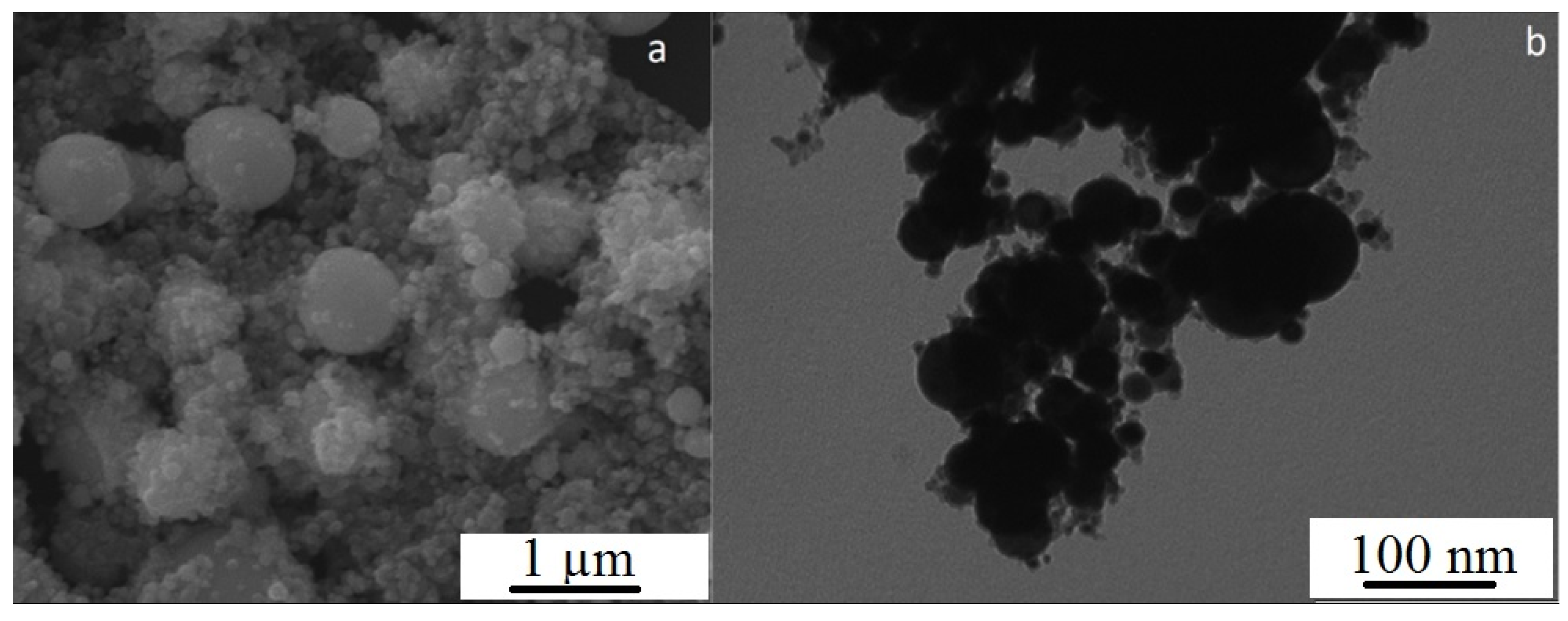
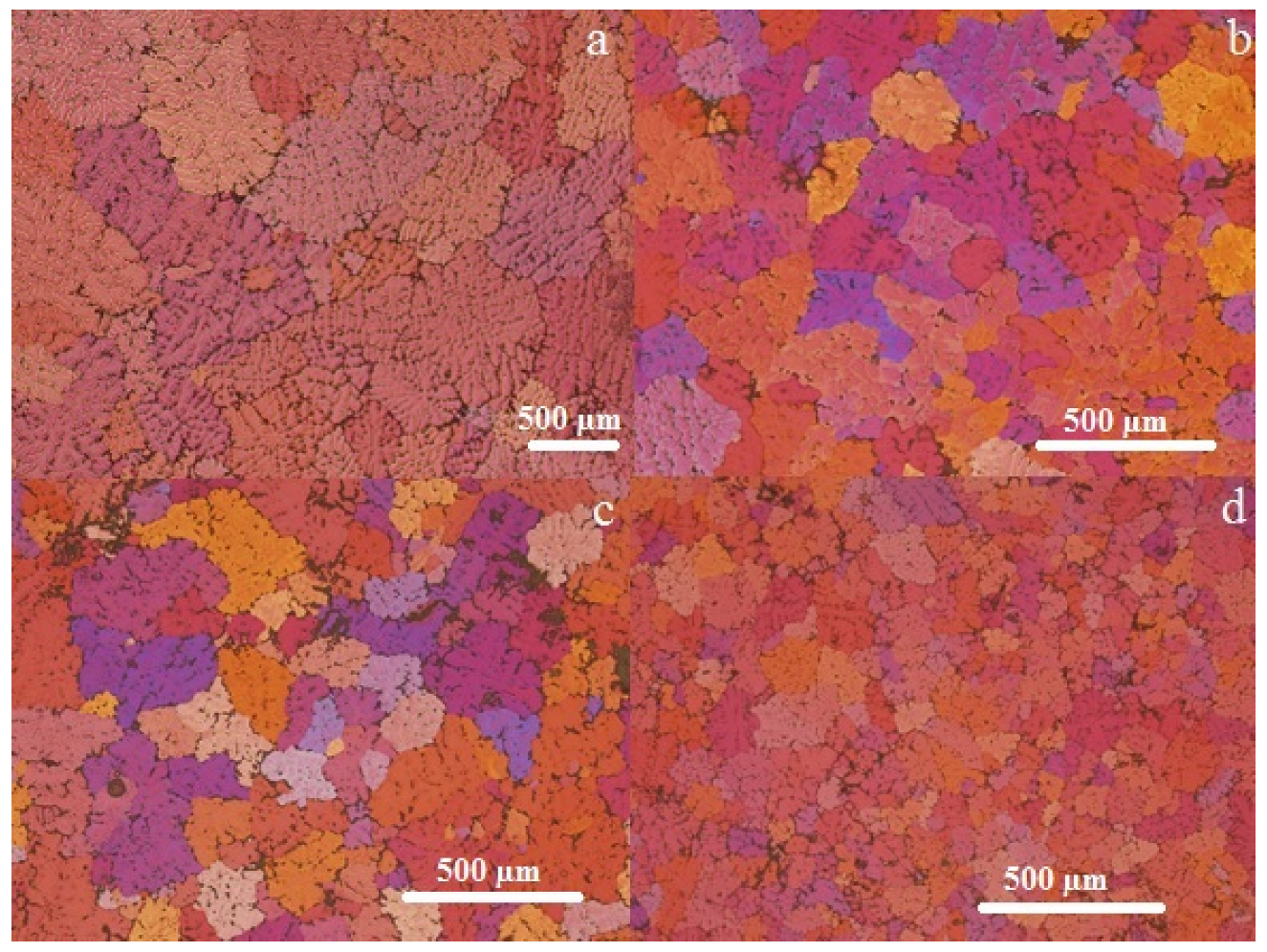
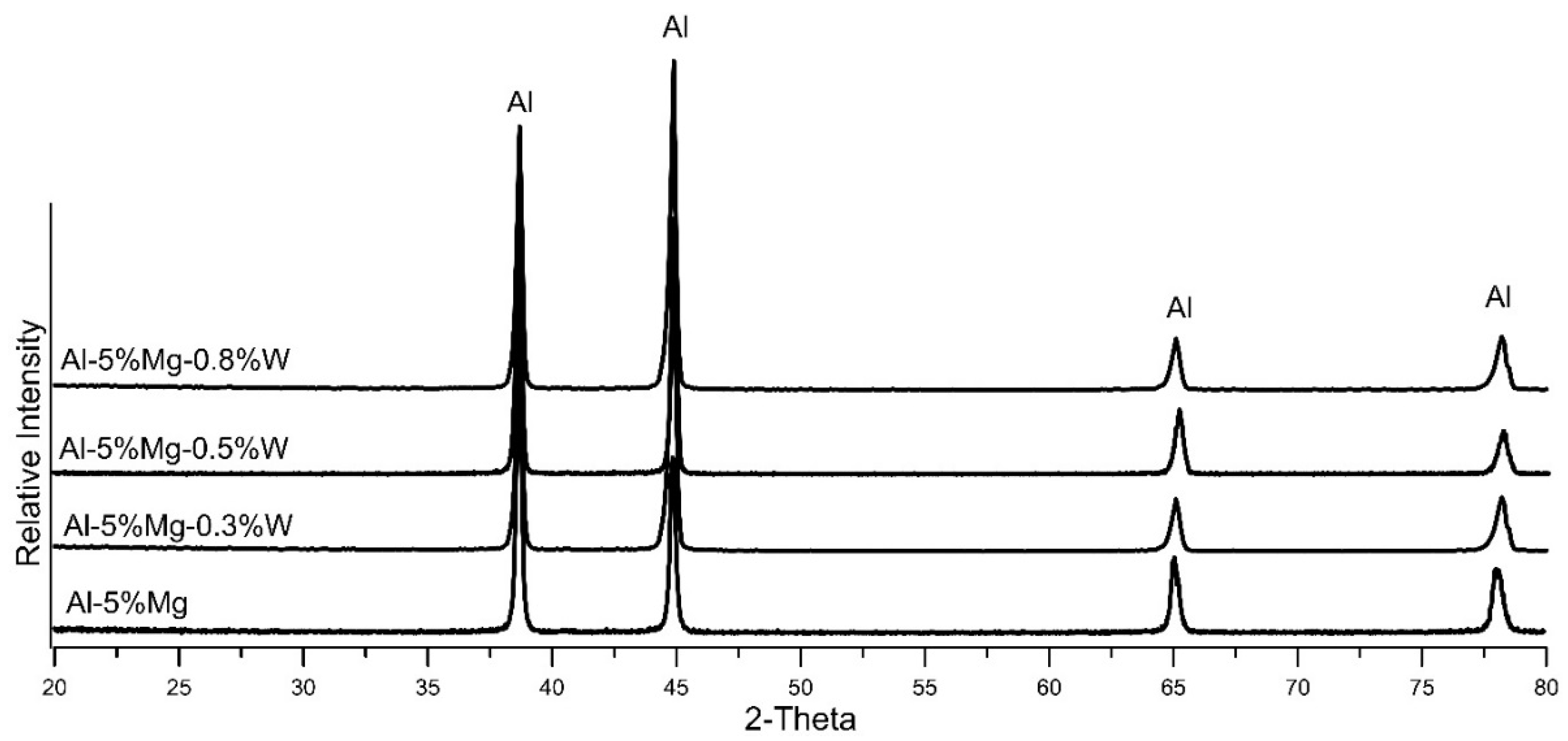

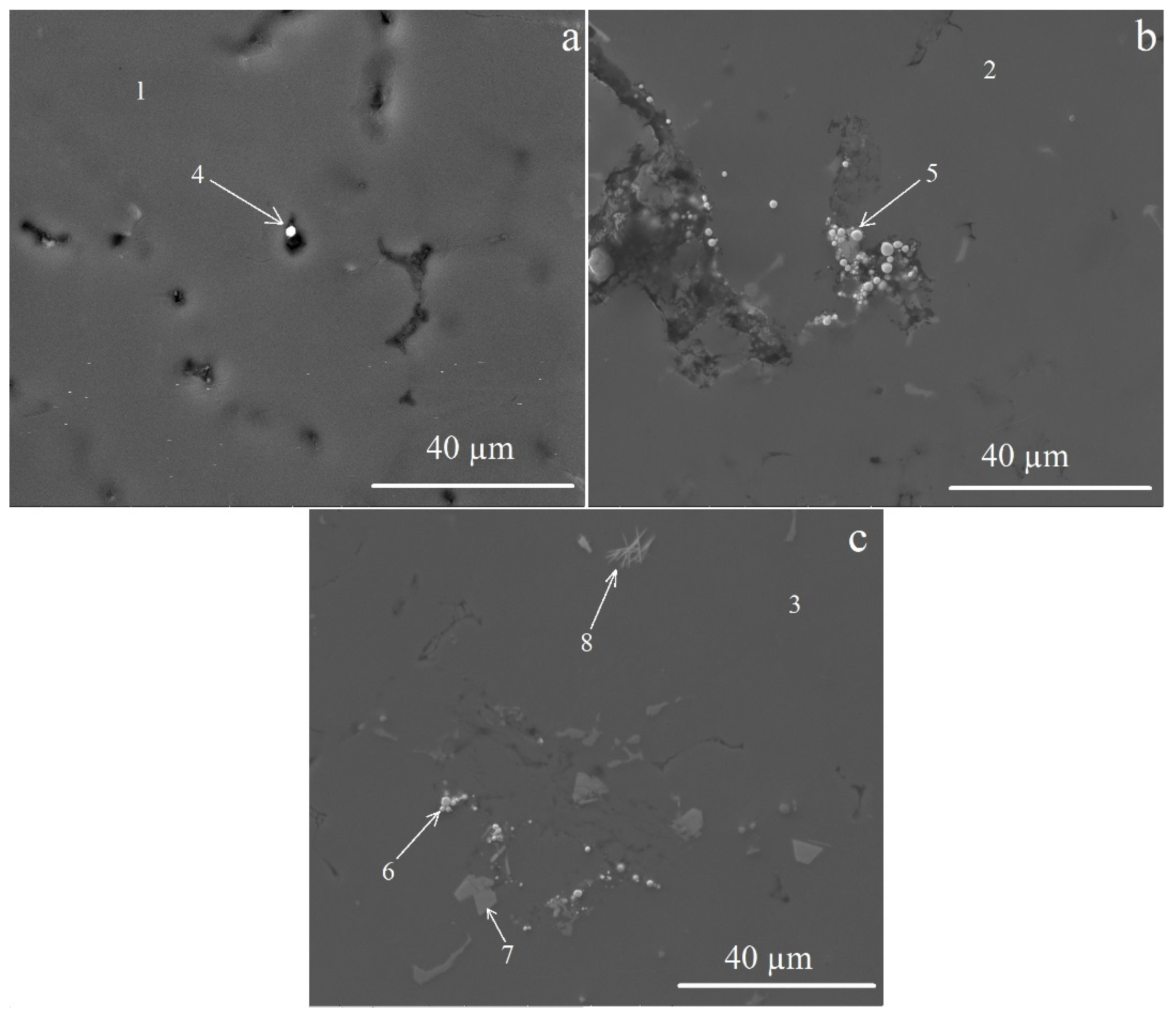
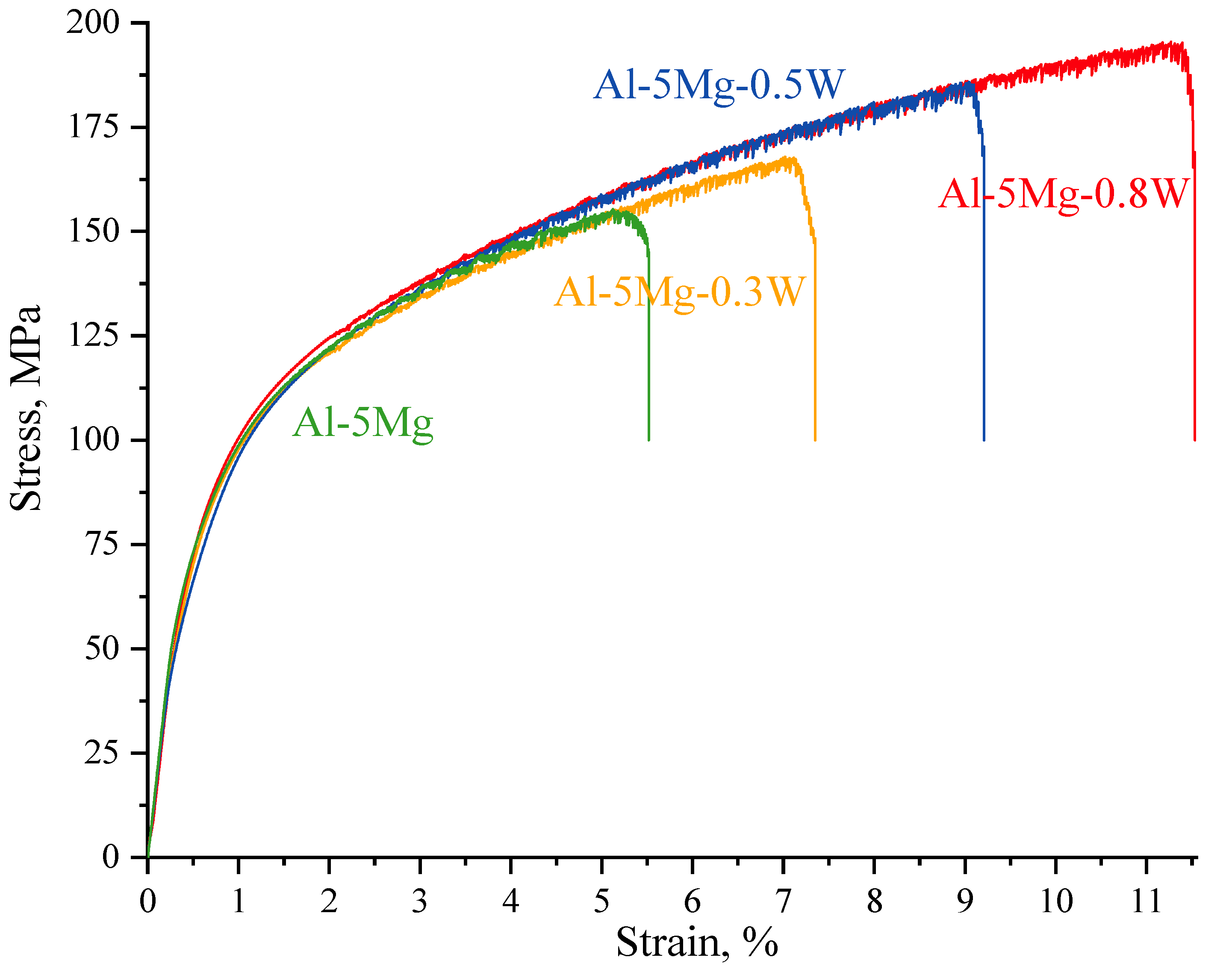

| Point Number | Al, wt% | W, wt.% | Mg, wt% | O, wt% |
|---|---|---|---|---|
| 1 | 87.75 | - | 3.07 | 9.18 |
| 2 | 81.92 | - | 4.73 | 13.35 |
| 3 | 93.69 | - | 2.09 | 4.22 |
| 4 | - | 100 | - | - |
| 5 | 19.62 | 80.38 | - | - |
| 6 | 0.79 | 99.21 | - | - |
| 7 | 80.16 | 19.84 | - | - |
| 8 | 56.78 | 43.22 | - | - |
| Alloy | Grain Size, µm | Hardness, HB | Microhardness, HV | σ0.2, MPa | σB, MPa | εmax, % |
|---|---|---|---|---|---|---|
| Al-5Mg | 180 ± 5 | 57 ± 3 | 68 ± 9 | 80 ± 2 | 155 ± 6 | 5.2 ± 0.4 |
| Al-5Mg-0.3W | 164 ± 4 | 64 ± 1.2 | 71 ± 10 | 85 ± 1.6 | 164 ± 5 | 6.4 ± 0.7 |
| Al-5Mg-0.5W | 149± 6 | 69 ± 1 | 73 ± 9 | 79 ± 1 | 185 ± 7 | 8.5 ± 0.5 |
| Al-5Mg-0.8W | 95± 4 | 75 ± 2 | 81 ± 7 | 91 ± 2.2 | 194 ± 6 | 10.3 ± 0.7 |
Publisher’s Note: MDPI stays neutral with regard to jurisdictional claims in published maps and institutional affiliations. |
© 2022 by the authors. Licensee MDPI, Basel, Switzerland. This article is an open access article distributed under the terms and conditions of the Creative Commons Attribution (CC BY) license (https://creativecommons.org/licenses/by/4.0/).
Share and Cite
Khrustalyov, A.; Kakhidze, N.; Platov, V.; Zhukov, I.; Vorozhtsov, A. Influence of Tungsten Nanoparticles on Microstructure and Mechanical Properties of an Al-5%Mg Alloy Produced by Casting. Metals 2022, 12, 989. https://doi.org/10.3390/met12060989
Khrustalyov A, Kakhidze N, Platov V, Zhukov I, Vorozhtsov A. Influence of Tungsten Nanoparticles on Microstructure and Mechanical Properties of an Al-5%Mg Alloy Produced by Casting. Metals. 2022; 12(6):989. https://doi.org/10.3390/met12060989
Chicago/Turabian StyleKhrustalyov, Anton, Nikolay Kakhidze, Vladimir Platov, Ilya Zhukov, and Alexander Vorozhtsov. 2022. "Influence of Tungsten Nanoparticles on Microstructure and Mechanical Properties of an Al-5%Mg Alloy Produced by Casting" Metals 12, no. 6: 989. https://doi.org/10.3390/met12060989





